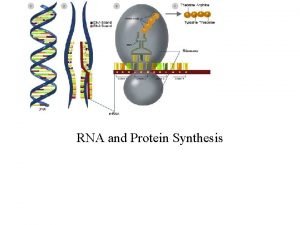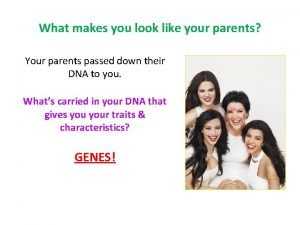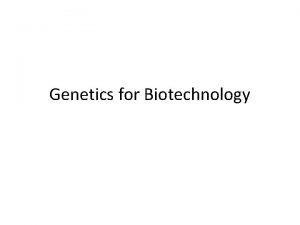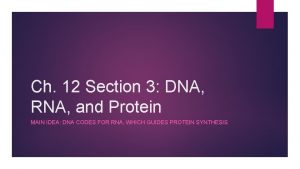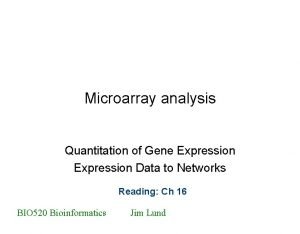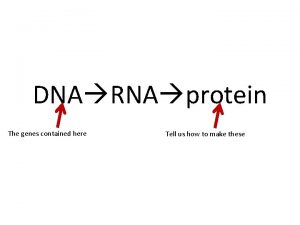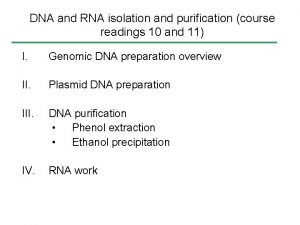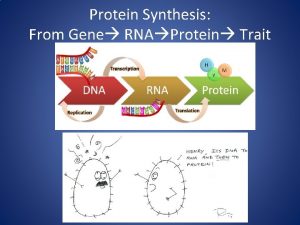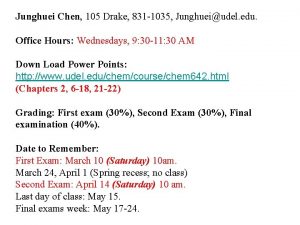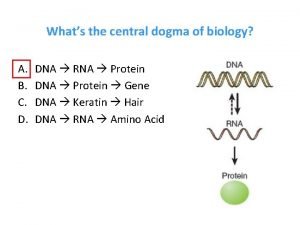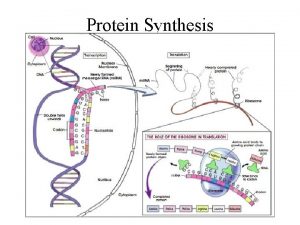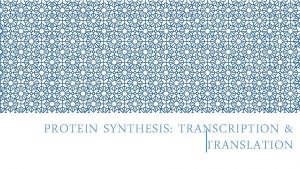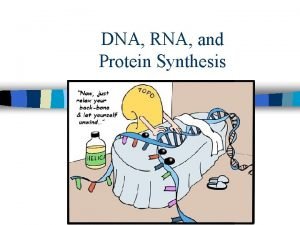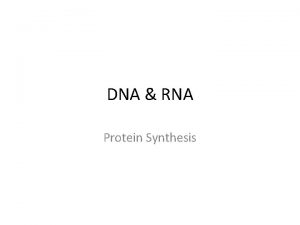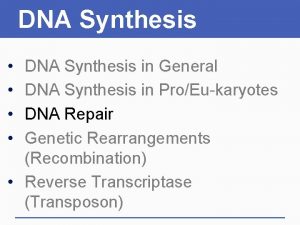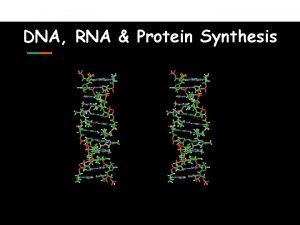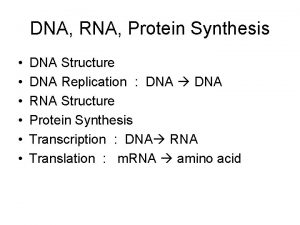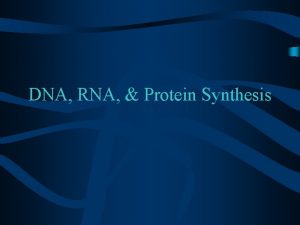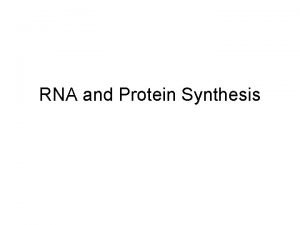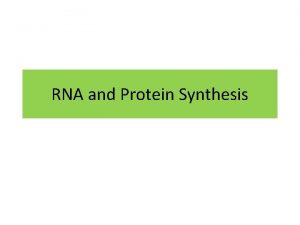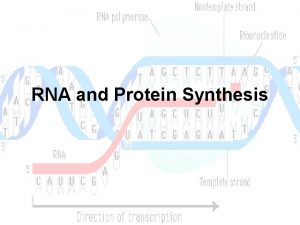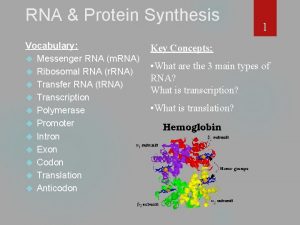RNA Protein synthesis DNA vs RNA DNA can



















- Slides: 19

RNA & Protein synthesis

DNA vs. RNA • DNA can be compared to the “master plan” of a builder • It stays safely in the nucleus (office) • Double stranded • Contains thymine • Contains deoxyribose • RNA can be compared to the “disposable copies/blueprints” • It goes to the proteinbuilding ribosome site in the cytoplasm (job site) • RNA is made from the DNA • Single stranded • Contains uracil • Contains ribose

How are genes expressed? • Genes are coded DNA instructions that control the production of proteins within the cell. • The 1 st step in decoding the DNA is to copy part of the nucleotide sequence into RNA • RNA = ribonucleic acid • The RNA’s make proteins

What is RNA? • RNA consists of a long chain of nucleotides (like DNA) – A sugar called ribose – A phosphate group – A nitrogenous base Adenine (A) Uracil (U) … not Thymine (T) Cytosine (C) Guanine (G) • RNA is single-stranded

RNA Nucleotide Phosphate Group Nitrogenous Base Ribose Sugar

RNA Structure ate Phosph Group Nitrogenous Base Ribose Sugar

Types of RNA • RNA’s assemble amino acids into proteins • There are 3 types of RNA – Messenger RNA (m. RNA) – Ribosomal RNA (r. RNA) – Transfer RNA (t. RNA)

Messenger RNA • Copies instructions in genes • Serves as a “messenger” from the DNA to the cell

Ribosomal RNA • Ribosomes make proteins • Ribosomes are made of proteins and contain their own RNA

Transfer RNA • Transfer amino acids to ribosomes based on specified codes in m. RNA

Section 12 -3 Go to Section:

How is RNA made? • RNA is made by transcription: DNA to RNA • Transcription uses an enzyme RNA polymerase • During transcription, RNA polymerase binds to DNA and separates the DNA strands, RNA polymerase then uses one strand of DNA as a template (stencil) from which nucleotides are assembled into a strand of RNA – For example: DNA: RNA: ACTGTGGACCT UGACACCUGGA http: //www. johnkyrk. com/DNAtranscription. html TRANSCRIPTION

The Genetic Code • Remember: Proteins are chains of amino acids called polypeptides • The order of the amino acids determines the properties of the protein • The instructions for making different amino acids are in the m. RNA = the genetic code • The genetic codes is read 3 letters at a time, so each “word” is 3 bases long = codon

How are proteins made? • Proteins are made by translation: RNA to protein • Translation occurs in the cytoplasm • During translation, the cell uses information from m. RNA to make proteins. • m. RNA instructs amino acids on t. RNA to join together in the ribosome containing r. RNA http: //www. johnkyrk. com/DNAtranslation. html


What is t. RNA again? • Transfer RNA brings amino acids to the ribosome. • One end of the t. RNA has an amino acid, the other end has 3 bases called the anticodon, that are complementary to one of the m. RNA codons Amino acid Anticodon

Codons • Three consecutive nucleotides that specify a single amino acid that is to be added to the polypeptide – For example: RNA: Codons: UCGCACGGU UCG-CAC-GGU Amino acids: Serine-Histidine-Glycine There are 64 possible codon combinations, but there are only 20 amino acids! *More than one codon can code for an amino acid

When does it begin or end? • There is 1 “start” codon that initiates protein synthesis if it is the 1 st codon (otherwise it codes for an amino acid) – AUG • There are 3 “stop” codons that do not code for any amino acid and signify the end of a polypeptide. – UAA – UAG – UGA

Let’s try to make a protein! • • • DNA: CCAGATAGGTTT m. RNA: GGUCUAUCCAAA codons: GGU-CUA-UCC-AAA t. RNA: CCA-GAU-AGG-UUU Amino acids for the m. RNA codons on t. RNA’s: Glycine-Leucine-Serine-Lysine
 Dna rna protein synthesis homework #2 dna replication
Dna rna protein synthesis homework #2 dna replication Dna protein synthesis study guide answers
Dna protein synthesis study guide answers Rna protein synthesis
Rna protein synthesis Section 12 3 rna and protein synthesis
Section 12 3 rna and protein synthesis Order of bases in dna
Order of bases in dna Section 12 3 rna and protein synthesis
Section 12 3 rna and protein synthesis Dna rna protein central dogma
Dna rna protein central dogma Dna rna protein central dogma
Dna rna protein central dogma Chapter 12 section 3 dna rna and protein
Chapter 12 section 3 dna rna and protein Dna rna protein
Dna rna protein Dna rna protein
Dna rna protein Dna rna protein diagram
Dna rna protein diagram Protein
Protein Synthesis of rna
Synthesis of rna Restaurant analogy
Restaurant analogy Translation or transcription
Translation or transcription Protein synthesis gcse
Protein synthesis gcse Missense mutation in sickle cell anemia
Missense mutation in sickle cell anemia Cookie monster analogy
Cookie monster analogy Whats translation in biology
Whats translation in biology





